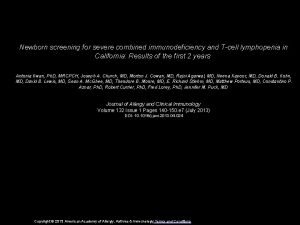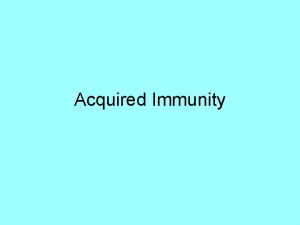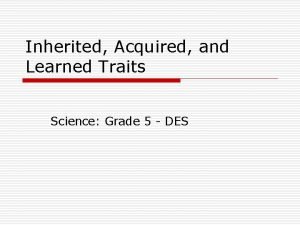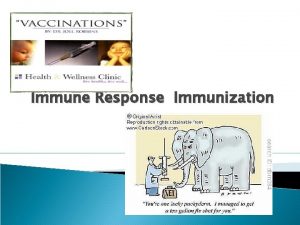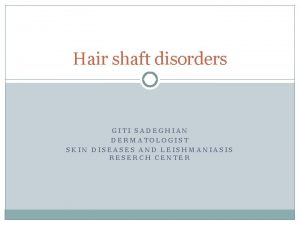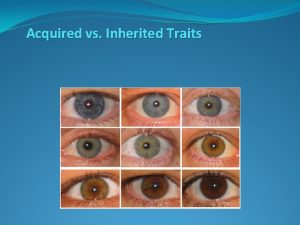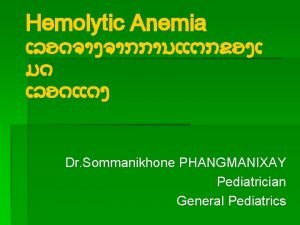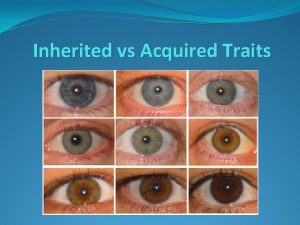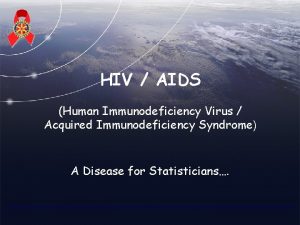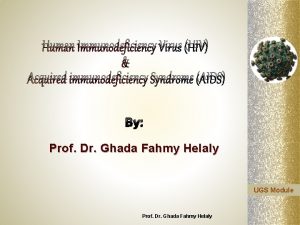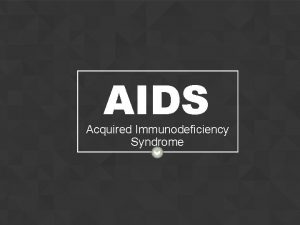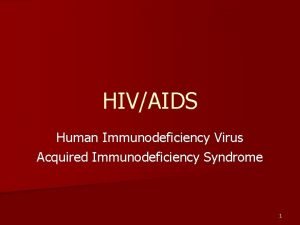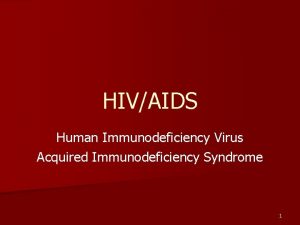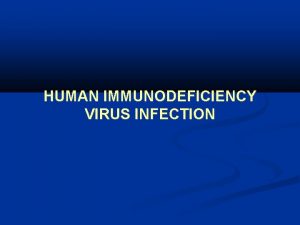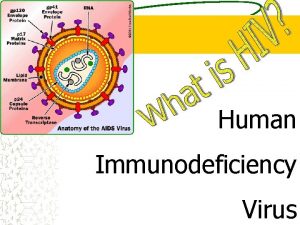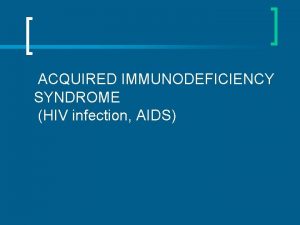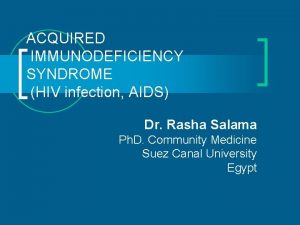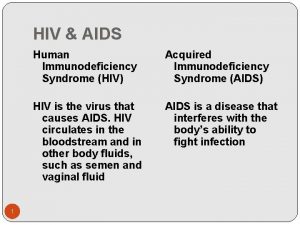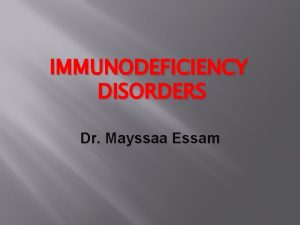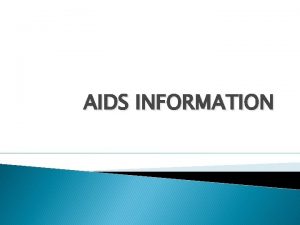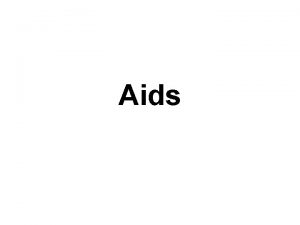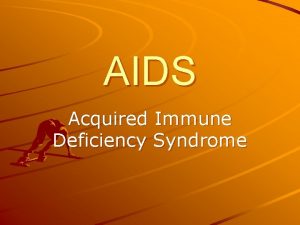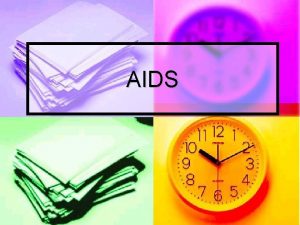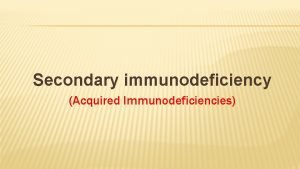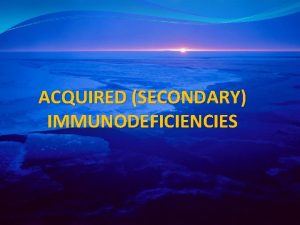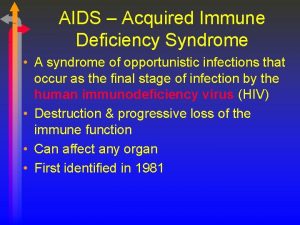Acquired Immunodeficiency Syndrome AIDS Acquired Immunodeficiency Syndrome AIDS






























- Slides: 30

Acquired Immunodeficiency Syndrome (AIDS)

Acquired Immunodeficiency Syndrome (AIDS) History u 1950 s: Blood samples from Africa have HIV antibodies. u 1976: First known AIDS patient died. u 1980: First human retrovirus isolated (HTLV-1). u 1981: First reports of “Acquired Immunodeficiency Syndrome” in Los Angeles. u 1983: Virus first isolated in France (LAV). u 1984: Virus isolated in the U. S. (called HTLV-III and AIDS-Related Virus, ARV). u 1985: Development and implementation of antibody test to screen blood donors.

Acquired Immunodeficiency Syndrome (AIDS) History (Continued) u 1986: Consensus name Human Immunodeficiency Virus (HIV-1). Related virus (HIV-2) identified. u 1992: AIDS becomes the leading cause of death among adults ages 25 -44 in the U. S. u 1997: Mortality rates of AIDS starts to decline due to the introduction of new drug cocktails. u 2001: World Health Organization predicts up to 40 million infected individuals. More than 22 million have already died.

AIDS: A Leading Cause of Death Among People Aged 25 -44 years in U. S. Deaths per 100, 000 people aged 25 -44 years

People Living with HIV/AIDS by End of 2001 North America 950, 000 Western Europe 560, 000 East Europe & Central Asia 1’ 000, 000 East Asia & Pacific 1’ 000, 000 Caribbean 420, 000 North Africa & Middle East 500, 000 South/South East Asia 5. 6 million Latin America 1. 5 million Sub-Saharan Africa 28. 5 million Australia & New Zealand 15, 000 Total: 40 million people

Structure of the Human Immunodeficiency Virus HIV is a Retrovirus

Life Cycle of HIV 1. Attachment: Virus binds to surface molecule (CD 4) of T helper cells and macrophages. F Coreceptors: Required for HIV infection. F CXCR 4 and CCR 5 mutants are resistant to infection. 2. Fusion: Viral envelope fuses with cell membrane, releasing contents into the cell.

HIV Life Cycle: Attachment Requires CD 4 Receptor plus a Coreceptor

Life Cycle of HIV 3. Reverse Transcription: Viral RNA is converted into DNA by unique enzyme reverse transcriptase. Reverse transcriptase RNA -----------> DNA Reverse transcriptase is the target of several HIV drugs: AZT, dd. I, and dd. C.

HIV Life Cycle: Reverse Transcriptase Converts RNA into DNA

http: //www. evtv 1. com/player. aspx? itemnum=11388 A must see to review the medications for HIV Wait for the video to load

Life Cycle of HIV 4. Integration: Viral DNA is inserted into host cell chromosome by unique enzyme integrase. Integrated viral DNA may remain latent for years and is called a provirus. 5. Replication: Viral DNA is transcribed and RNA http: //www. evtv 1. com/player. a is translated, making viral proteins. spx? itemnum=11388 Viral genome is replicated. 6. Assembly: New viruses are made. 7. Release: New viruses bud through the cell membrane.

HIV Life Cycle: Latent versus Active Infection

HIV Life Cycle: Latent versus Active Infection in Macrophages

AIDS Associated Disease Categories 1. Gastrointestinal: Cause most of illness and death of late AIDS. Symptoms: u Diarrhea u Wasting (extreme weight loss) u Abdominal pain u Infections of the mouth and esophagus. Pathogens: Candida albicans, cytomegalovirus, Microsporidia, and Cryptosporidia.

African AIDS patient with slim disease Source: Tropical Medicine and Parasitiology, 1997

Opportunistic Oral Yeast Infection by Candida albicans in an AIDS Patient Source: Atlas of Clinical Oral Pathology, 1999

AIDS Associated Disease Categories 2. Respiratory: 70% of AIDS patients develop serious respiratory problems. Partial list of respiratory problems associated with AIDS: F Bronchitis F Pneumonia F Tuberculosis F Lung cancer F Sinusitis F Pneumonitis

Chest X-Ray of AIDS Patient with Tuberculosis

AIDS Associated Disease Categories 3. Neurological: Opportunistic diseases and tumors of central nervous system. Symptoms many include: Headaches, peripheral nerve problems, and AIDS dementia complex (Memory loss, motor problems, difficulty concentration, and paralysis).

AIDS Associated Disease Categories 4. Skin Disorders: 90% of AIDS patients develop skin or mucous membrane disorders. F Kaposi’s sarcoma • 1/3 male AIDS patients develop KS • Most common type of cancer in AIDS patients F Herpes zoster (shingles) F Herpes simplex F Thrush F Invasive cervical carcinoma 5. Eye Infections: 50 -75% patients develop eye conditions. F CMV retinitis F Conjunctivitis F Dry eye syndrome

Extensive tumor lesions of Kaposis’s sarcoma in AIDS patient. Source: AIDS, 1997

Chronic Herpes Simplex infection with lesions on tongue and lips. Source: Atlas of Clinical Oral Pathology, 1999.

Non-Hodgkin’s Lymphoma & ascites in AIDS patient Source: Tropical Medicine and Parasitiology, 1997

Drugs Against HIV u Reverse Transcriptase Inhibitors: Competitive enzyme inhibitors. Example: AZT, dd. I, dd. C. u Protease Inhibitors: Inhibit the viral proteases. Prevent viral maturation. u Problem with individual drug treatments: Resistance. u Drug Cocktails: A combination of: F One or two reverse transcriptase inhibitors F One or two protease inhibitors. u Drug cocktails have been very effective in suppressing HIV replication and prolonging the life of HIV infected individuals, but long term effectiveness is not clear.

Stages of HIV Infection

Antibody Levels, T Cell Counts, and HIV Concentration After Infection

Transmission of AIDS (Worldwide) 1. Sexual contact with infected individual: All forms of sexual intercourse (homosexual and heterosexual). 75% of transmission. 2. Sharing of unsterilized needles by intravenous drug users and unsafe medical practices: 510% of transmission. 3. Transfusions and Blood Products: Hemophiliac population was decimated in 1980 s. Risk is low today. 3 -5% of transmission. 4. Mother to Infant (Perinatal): 25% of children become infected in utero, during delivery, or by breast-feeding (with AZT only 3%). 5 -10% of transmission.

HIV Transmission in United States and Rest of the World

www. Wepapers. com/papers/76496/HIV_teasting. ppt click on the HIV Testing. ppt in the upper left Conner and walk through the testing slides
 What are deficiency
What are deficiency Severe combined immunodeficiency
Severe combined immunodeficiency Acquired traits
Acquired traits Juarez company acquired $1 200
Juarez company acquired $1 200 Hawaii date acquired
Hawaii date acquired Lance brothers enterprises acquired
Lance brothers enterprises acquired Acquired physical traits
Acquired physical traits Difference between acquired immunity and innate immunity
Difference between acquired immunity and innate immunity Acquired immunity definition
Acquired immunity definition What are some acquired traits
What are some acquired traits How knowledge is acquired represented and organized
How knowledge is acquired represented and organized Infer how the pigs acquired another case of whiskey.
Infer how the pigs acquired another case of whiskey. Acquired thrombophilia
Acquired thrombophilia Acquired traits
Acquired traits Acquired taste meaning
Acquired taste meaning Systemic acquired resistance in plants
Systemic acquired resistance in plants Training is the act of increasing the
Training is the act of increasing the Example of abiotic factor
Example of abiotic factor Naturally acquired passive immunity definition
Naturally acquired passive immunity definition Mexican cession date acquired
Mexican cession date acquired Examples of learned traits
Examples of learned traits Dr sadeghian
Dr sadeghian Acquired trait
Acquired trait Thrombophilia
Thrombophilia Causes of hemolysis
Causes of hemolysis Systemic acquired resistance in plants
Systemic acquired resistance in plants Acquired traits of a tiger
Acquired traits of a tiger Is conscience innate or acquired
Is conscience innate or acquired Acquired physical traits
Acquired physical traits Acquired needs theory
Acquired needs theory How are intangible resource stocks acquired?
How are intangible resource stocks acquired?

